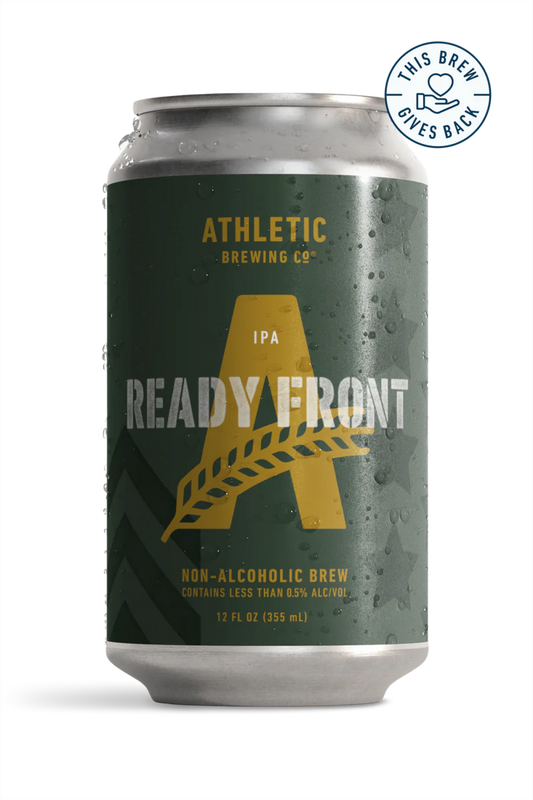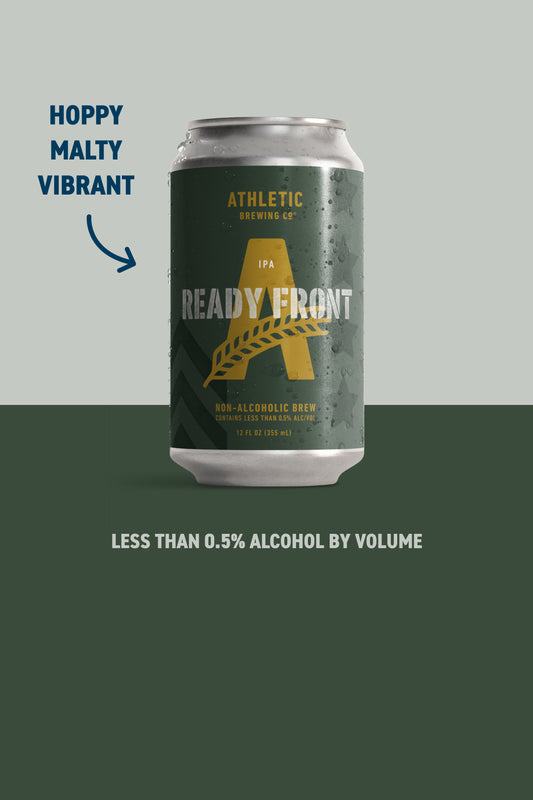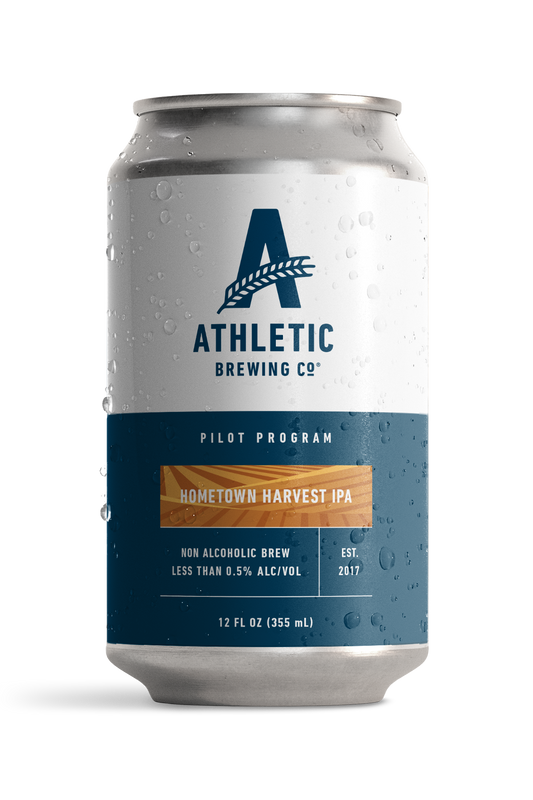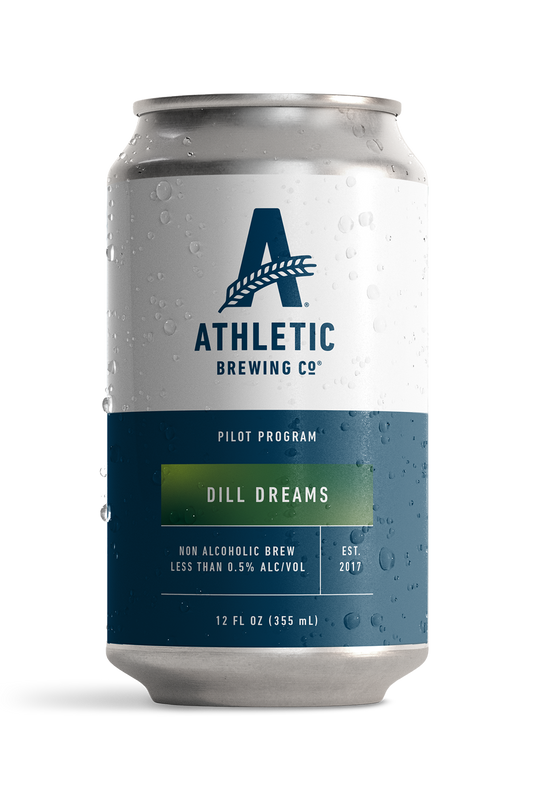We Chatted With Some of Our Athletes About Cycling Safety, Here’s What We Learned
It’s that time of year. The days are warming up, the snow is melting, and the wildflowers are blooming. This is what you’ve been waiting patiently for all winter. It’s time to toss a Free Wave in your pack, snag your helmet, and hit the pavement.
Whether you’re a seasoned pro or just starting to dabble in the world of road cycling, it’s crucial that you consider your safety while out on a ride.
Just last August, one of our Athletic Brewing teammates, Mason Gravley, was pedaling down the road during our celebratory cross-country ride when he was struck by the side-view mirror of a Ford F-150. The driver of the truck was attempting what is called “buzzing,” where a motorist swerves their vehicle closely to a cyclist with the intention of making the cyclist uncomfortable. It’s an aggressive, dangerous, and illegal move sometimes executed by those who feel hostility towards cyclists.

The side-view mirror of the truck shattered as it came into contact with his body, sending plastic and glass across the road. Having completed half a dozen cross-country rides, Gravely is no cycling noob either. Fortunately, he wasn’t seriously injured and was able to finish out his ride for the day. But it could have been far worse.
Just a couple of months after Gravley was struck, another one of our Athletic Brewing ambassadors, Daniel Hurd, was slammed into from behind while riding his bike in Arizona. He was rushed to the hospital with a traumatic brain injury, road rash on his face, and extensive soft tissue injuries on his legs that required three surgeries and a skin graft.
Hurd was at the tail-end of a massive undertaking to cycle each of the 48 contiguous states to bring awareness to suicide prevention and to gain support for his nonprofit organization, One Pedal at a Time. Hurd was riding down the road when the vehicle, a Ford Escape, slammed into him from behind. He was hauling a small trailer behind his bike that served as the space where he lived throughout the duration of this project, and it’s quite likely that he wouldn’t be alive today if the car hadn’t struck the trailer first.

While these experiences are intense, they are not the norm for most cyclists but serve as examples of what can happen. Don’t let it discourage you from riding. While there are more cyclists than ever hitting the roads in the United States, bike accidents are on the decline overall. Cycling is not innately unsafe; it is actually quite safe. Unfortunately, in the United States, we don’t have stats that show us cycling fatalities per miles traveled, but if we extrapolate from data collected in Great Britain, cycling is about as safe as walking, and a vast majority of us don’t believe walking is dangerous.
Cycling is an excellent way to get outside, get some fresh air, and get some low-impact exercise. Not only is it fun, but cycling can improve your overall health by lowering blood pressure, reducing your risk of heart disease, and helping you manage your mental health, among other benefits. For Hurd, cycling had a huge impact on his health, especially his mental health. He found focus and meaning, and lost a lot of weight. The activity quite literally saved his life.
Wear a Helmet
The most obvious place to start managing your safety is to wear a helmet while on a bike. It may seem obvious, but there are a lot of people who skip this crucial piece of gear. “I see a lot of people that ride with no helmets,” says Hurd. “I ended up with a TBI [traumatic brain injury]... but I wouldn’t have survived without my helmet on.”

Proper fit is extremely important when choosing a helmet. The helmet should be snug, but not migraine-inducing. Most helmets have replaceable pads on the inside to adjust the fit. There should be very little room for it to move around on your head. The last thing you want is for your helmet to fall over your eyes, or even fall off. Secure the chin strap so that you can only get one finger in between the strap and your chin. Watch this short video from the National Highway Safety Administration to see how a helmet should fit.
Your helmet should meet the requirements of the Consumer Product Safety Commission (CPSC). Any bike helmet that does not meet these requirements is in violation of the Consumer Product Safety Act, which provides guidelines and requirements for the efficacy of the helmets.
It might take some time to find the right helmet for you, but it’s worth the search.
While a helmet may help you survive a crash, it does nothing to prevent a crash. The goal with cycling safety is to avoid a collision, not just merely survive one.
See and Be Seen
If you’ve ever taken a class to get your motorcycle license, one of the things you’re taught is to act as if everyone is out to get you. It might seem extreme, but it instills the message that you need to stay alert and cautious, and pay very close attention to what other people are doing. This is defensive driving, and the same principle applies for cycling. It's imperative that you keep your eyes and ears open and be very aware of your surroundings. You can’t trust someone else to keep you safe, i.e., the drivers on the road. It’s up to you to take care of your safety. Look, listen, and be aware. Exercise caution, because you can’t know for sure if a driver of a vehicle has seen you or not.

Athletic Brewing Ambassador and trans-America cyclist Jason Hardrath knows this from experience. “Assume drivers will pull out in front of you from parking lots,” he says, “and watch out for vehicles that pass you and immediately make a turn in front of you.”
Hardrath recalls that both of the instances where he’s experienced a collision with a vehicle was after he had made eye contact with the driver. Both times, he had right-of-way and the driver pulled out in front of him. He ended up in the bed of an El Camino in one of those experiences, and rolled across the hood of a car in the other. Thankfully, both he and his bike were unharmed. The takeaway here is to never assume the other person sees you.
Hurd adds, “Keep your head on a swivel. Things can change really quick ... so being aware of what’s going on is really important.”
Cycling clothing and gear is typically made using bright colors and reflective materials in order to catch the attention of motorists. One study showed that wearing fluorescent colored clothing on the legs is more effective at catching a motorists attention than a fluorescent jersey with dark or dull colored leg coverings. This is because humans are built to recognize other humans and seeing legs moving in a specific way sparks that recognition more than a stationary upper body.
In the same study, motorists were more likely to notice a cyclist if they had a tail light. Even better was a flashing tail light, and even better than that was wearing solid (non flashing) lights on the ankles. Any light is better than no light, and it’s important to use them any time, day or night.
You should also ride in such a way that you are predictable to a driver. A motorist that is unsure of where you are going or what you might do next is more likely to make a move that can put you in danger. Using hand signals aids in this predictability, as well as avoiding distractions like looking at your phone, listening to music, or riding intoxicated.
Improve Your Cycling Skills
Having all the fancy gear, bright clothing, and flashing lights will not guarantee your safety. It’s up to you to cultivate the necessary skills in order to be a proficient cyclist. Proficiency means that you can better maneuver your bike to avoid collisions.
If you’re a cycling novice, it’s a good idea to find an on-bike class that will teach you the skills you need on the road. Go to the local bike shop to find out if there are safety classes or skills courses available nearby, then find a place that is free of traffic to practice what you learn. Practice looking over your shoulders while riding in a straight line and riding while signaling with your hands.
There are many scenarios involving vehicle traffic that require experience and knowledge to navigate safely. Knowing the laws will help you learn how to act in certain situations, like intersections. Laws vary depending on location, but most bicycle laws require that you obey the same laws as motorists, this includes riding in the same directional flow as car traffic and not riding on sidewalks.
Plan your cycling routes to use less busy streets, streets with lower speed limits, and better infrastructure made for bikes. Most bicycle-car accidents occur between 6-9 p.m., so avoid riding at this time if possible.
Be a Safe Driver
You can’t control what other people do and the way they drive, but you can set an example and help educate others by being a safe driver yourself.

Those signs that say “Share the Road” are not made for the bikes: Those are there to remind motor vehicle operators that bikes are legally entitled to use the road, and yes, even the entire lane. Some (or most) motorists take the sign to mean that the cyclists must share the road by getting out of the way, or that they can drive side-by-side with the bikes. In reality, motorists must slow down and drive behind the bicycle until it is safe to pass. Most states have laws that require drivers to give the cyclist a certain amount of space when passing them. Don’t underestimate the speed that a bike might be moving at — they may be moving as fast or faster than car traffic. And never pull out in front of bikes; yield to them as you would another vehicle.
You can also be an advocate for bike safety by getting involved or supporting local groups, and by voting in favor of developing bike-safe infrastructure.
The Future of Cycling Safety
It’s said that the number one enemy of a cyclist is a distracted motorist. Trek bicycles has teamed up with Ford Motor Company and Bosch to create new software that will (hopefully) become standard in the car manufacturing industry — and that is to make cars that can signal to a driver that there is a cyclist nearby. All the cyclist would need to do is carry or attach a device that can communicate with the vehicles via Bluetooth. With the amazing technology available in most new cars, it’s a wonder that this hasn’t already been done.
With new technology, better infrastructure, and both drivers and cyclists being more aware, the future of cycling safety looks bright.
























 Your Privacy Choices
Your Privacy Choices











